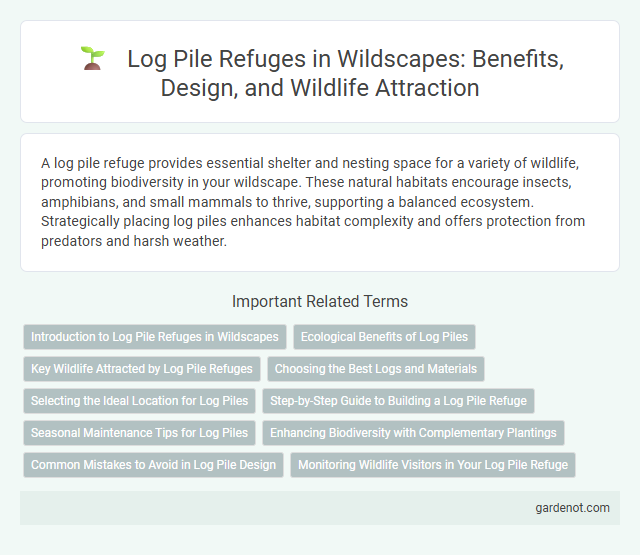A log pile refuge provides essential shelter and nesting space for a variety of wildlife, promoting biodiversity in your wildscape. These natural habitats encourage insects, amphibians, and small mammals to thrive, supporting a balanced ecosystem. Strategically placing log piles enhances habitat complexity and offers protection from predators and harsh weather.
Introduction to Log Pile Refuges in Wildscapes
Log pile refuges in wildscapes serve as essential habitats that promote biodiversity by providing shelter and breeding grounds for insects, amphibians, and small mammals. These natural structures help maintain ecological balance by supporting decomposers and predator-prey interactions within the environment. Incorporating log piles enhances soil health and fosters a thriving microhabitat critical for sustaining wildlife populations.
Ecological Benefits of Log Piles
Log pile refuges create essential habitats for a variety of wildlife, including insects, amphibians, and small mammals, promoting biodiversity. They enhance soil health by facilitating decomposition and nutrient cycling through fungal and microbial activity within the wood. These structures also contribute to ecosystem stability by providing shelter and breeding sites, supporting food webs in natural and managed landscapes.
Key Wildlife Attracted by Log Pile Refuges
Log pile refuges attract key wildlife such as amphibians, reptiles, and small mammals, offering essential shelter and breeding sites. Hedgehogs frequently use log piles for nesting and hibernation, while frogs and newts benefit from moist, shaded conditions ideal for laying eggs. These habitats also support invertebrates like beetles and spiders, which contribute to biodiversity and ecosystem health in wildscapes.
Choosing the Best Logs and Materials
Selecting the best logs for a wildscape log pile refuge involves choosing hardwoods like oak or ash that resist decay and support diverse insect populations. Incorporating a mix of deadwood sizes and types, including branches, bark, and twigs, enhances habitat complexity and provides shelter for amphibians, reptiles, and invertebrates. Avoid treated or painted wood to ensure a healthy and chemical-free environment for wildlife.
Selecting the Ideal Location for Log Piles
Choosing the ideal location for a log pile refuge involves placing it in a sheltered, moist area that mimics natural habitats for insects and amphibians. Positioning the log pile near garden borders, hedgerows, or under trees enhances biodiversity by providing shelter and food sources for beneficial wildlife. Ensuring partial shade and avoiding direct exposure to harsh weather conditions maximizes the log pile's effectiveness as a wildlife haven.
Step-by-Step Guide to Building a Log Pile Refuge
Building a log pile refuge involves selecting dry, untreated wood logs of varying sizes to create a dense habitat structure that supports wildlife such as insects, amphibians, and small mammals. Begin by clearing a ground area with good drainage, then stack logs horizontally in layers, ensuring gaps and crevices to provide shelter and breeding sites. Incorporate leaves, bark, and branches between logs to enhance biodiversity, and position the pile in a sheltered, shaded spot to maximize habitat value.
Seasonal Maintenance Tips for Log Piles
Regularly inspect log piles for moisture buildup to prevent mold and decay, promoting a healthy habitat for wildlife like hedgehogs and insects. Remove accumulated leaves and debris each season to enhance airflow and reduce the risk of fungal growth. Position logs off the ground using stones or pallets to improve drainage and prolong the life of the refuge.
Enhancing Biodiversity with Complementary Plantings
Log pile refuges play a crucial role in enhancing biodiversity by providing essential habitats for insects, amphibians, and small mammals. Complementary plantings, such as native wildflowers and shrubs, support these refuges by offering food sources and shelter, creating a balanced ecosystem. Integrating diverse plant species around log piles improves habitat connectivity and promotes ecological resilience in wildscapes.
Common Mistakes to Avoid in Log Pile Design
Log pile refuges often suffer from poor placement, which reduces their effectiveness for wildlife shelter; ensure they are located in safe, undisturbed areas with natural cover. Using treated or painted wood can introduce harmful chemicals into the environment, so always choose untreated, natural logs to support biodiversity. Stacking logs too neatly or tightly limits the gaps necessary for small mammals and insects to utilize the refuge, so assemble piles in a loose, irregular fashion to maximize habitat suitability.
Monitoring Wildlife Visitors in Your Log Pile Refuge
Monitoring wildlife visitors in your log pile refuge involves regular observation to track species diversity and behavior. Detailed records of animal activity help identify peak visitation times and habitat preferences, enhancing habitat management. Utilizing motion-activated cameras and field notes supports accurate documentation and promotes effective conservation strategies within the wildscape.
Log pile refuge Infographic

 gardenot.com
gardenot.com